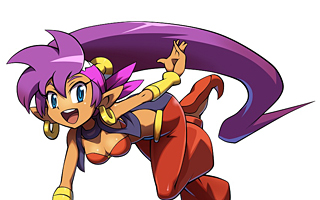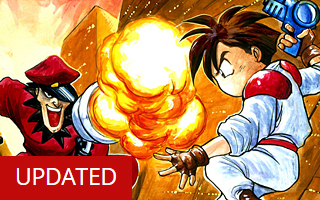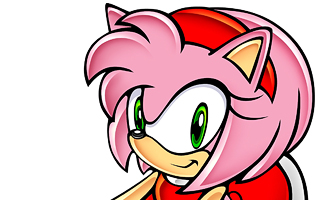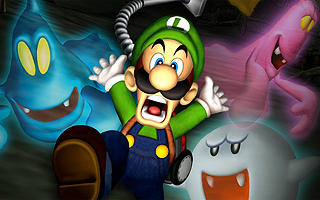Sega Genesis Mini Omissions
Top 10 Games Not on the Sega Genesis Mini!
The Sega Genesis Mini is a dedicated console that has over 40 built-in games. The system looks like a miniature version of Sega’s legendary 16-bit console, and the selection of games does a pretty good job of representing the era. Many of Sega’s most prolific titles are included, and there are some noteworthy third-party games as well. That being said, there are still a few glaring omissions that I would have liked to see featured. It should be noted that Sega is releasing different versions of the mini console in different territories, and the game selection varies from one region to the next. It’s unfortunate that games like M.U.S.H.A., Shining Force II, and Alien Storm aren’t available in the west. Likewise, it’s too bad that Japan is missing out on Shinobi III, Strider, and Earthworm Jim. For the purpose of this list, I’m only looking at games that aren’t included in any region. Keep in mind, also, that this isn’t simply a list of the best games that weren’t included. Rather, it’s a list of omitted games that I think best represent the console.
10
Mortal Kombat
1993

You can’t ignore the impact that Mortal Kombat had on the industry. Its over-the-top violence was the center of national debate, and the Genesis port became one of the best-selling third-party games ever released for the console. While the SNES counterpart was heavily censored, the Genesis version stayed true to the vision of the original arcade game. (Blood would fly with every punch, and the fatality moves were unaltered.) Sega positioned the Genesis as a mature alternative to Nintendo’s machine, and Mortal Kombat added legitimacy to these claims. I was never the biggest fan of the arcade game and the Genesis port was a little rough around the edges, but it helped define the 16-bit era. The roster is relatively sparse by today’s standards, but each character had a distinctive style and a unique moveset. The digitized characters made the game look like a kung fu movie, and the hard-hitting attacks felt energetic. The game’s M-rated nature made it an unlikely candidate to be included on the Genesis Mini, but if Sega’s Eternal Champions made the cut, there’s no reason why Mortal Kombat shouldn’t have been considered. Mortal Kombat would have been a nice companion piece to Street Fighter II, and it would have been amazing for the two most important fighting games of the 1990s to be included in the same package.
9
Ristar
1995

I was shocked to see that Ristar wasn’t included on the Genesis Mini. Sega developed and published the game themselves, so there should have been nothing preventing Ristar from making the cut. Playing Ristar, it’s almost impossible not to be reminded of Sonic the Hedgehog. This isn’t surprising, considering that Ristar was developed by Sonic Team. (In fact, Ristar himself was initially used as a prototype for everyone’s favorite blue hedgehog.) Ristar’s most defining characteristic is his ability to stretch out his arms and grab onto basically anything within reach. He can grab ledges, attach to walls, swing around on poles, utilize overhead bars to get across cliffs, or get a hold of his enemies and smash them into oblivion. The “extend-and-grab” mechanism is fun and inventive, and it helps set Ristar apart from other platformers. Unfortunately, the game arrived near the end of the Genesis’ life cycle, so many fans missed out on it completely. Late-era Genesis games don’t get as much attention as they probably deserve.
8
Virtua Racing
1994

The selection of games on the Genesis Mini represents a wide cross section of genres, so I was surprised that the lineup didn’t include a single racing game. Sega made a lot of great racing games in the ’80s and ’90s, and there are many options to choose from. No racing game pushed the Genesis harder than Virtua Racing did, so it’s the perfect candidate for this list. When Virtua Racing was released in arcades in 1992, it helped push the medium forward with its use of 3D polygonal graphics. It wasn’t the first game to use polygons, but its high frame rate and immersive camera angles made Virtua Racing stand out. The Genesis wasn’t any wear near as powerful as Sega’s Model 1 arcade boards, so a home console port seemed unlikely. After Nintendo struck gold with StarFox and the Super FX chip in 1993, Sega decided it would be worthwhile to expand the capabilities of the Genesis. The “Sega Virtua Processor” made it possible for Virtua Racing to run on the Genesis. The home port didn’t look as polished as the arcade original, but it was surreal to see polygonal graphics on the Genesis in 1994. (The game’s $90 price tag was also surreal, but that’s another story.) Virtua Racing pushed the console beyond its limits, and it deserves to be included on the Genesis Mini for that reason alone.
7
Zombies Ate My Neighbors
1993

I mentioned Zombies Ate My Neighbors on my list of most glaring omissions on the SNES Classic, and the Genesis version deserves some attention too. It’s arguably the best co-op game on the entire system, after all, and it would add value to the second controller that comes with the console. For the uninitiated, Zombies Ate My Neighbors is centered around a pair of kids who are trying to save their neighborhood from nefarious forces. Zombies, mummies, mutants, aliens, and giant babies are among the enemies you’ll encounter in the game. Thankfully, the heroes are extremely resourceful, and they’re able to use everything from pop cans to water guns as makeshift weapons. It’s more lighthearted than something like Resident Evil, and that’s a good thing in this case. Zombies Ate My Neighbors is a parodical take on classic monster movies, and it’s deeply embedded with LucasArts’ trademark humor and wit. It never takes itself too seriously, and nearly every one of the game’s 55 levels offers something different. The Genesis version of the game isn’t quite as colorful as the SNES version and the side menu is a little distracting, but the differences are trivial. Mowing down zombies with a weed whacker is fun, regardless of how many colors happen to be on screen.
6
Herzog Zwei
1989

Herzog Zwei is an oft-overlooked title from 1989 and one of the earliest examples of a real-time strategy game. It inspired other landmark games like Dune II and Warcraft, and it was a precursor to the MOBA genre. In the game, players take control of a flying mecha that could be likened to the variable fighters from the Macross franchise. Players are tasked with purchasing combat units, placing them across the battlefield, and giving them directions. There are eight different types of units that can be purchased, and players have to be mindful of things like fuel and ammunition. The game requires considerable micromanagement, and there are many strategies that can be implemented. This is especially true when you’re competing against a second player. Herzog Zwei received mixed reviews upon release – one reviewer at Electronic Gaming Monthly gave it a 3! – but it’s now regarded as one of the most innovative games ever released on the Genesis. There weren’t many games from the era that were remotely like Herzog Zwei, so it could have added a lot of variety to the Genesis Mini lineup.
5
Aladdin
1993

Licensing issues make Aladdin an unlikely candidate for this list, but the Genesis Mini features two Mickey Mouse games, so I don’t think it was beyond the realm of possibility for another game to be added. Aladdin is a fairly typical side-scrolling platformer with straightforward level design and simple play mechanics. As Aladdin, you’ll run around the levels jumping from one platform to the next, attacking with a sword or keeping your enemies at bay by throwing apples at them. While certain elements of the game are pedestrian in nature, there is one area in which the game shines like a diamond in the rough. Whether or not the game itself is better than Capcom’s version of Aladdin for the SNES is a matter of personal choice, but most would agree that the graphics in the Genesis version more closely resemble the visuals from the movie. This is because the game’s sprites were provided by Walt Disney Feature Animation. Virgin Games worked closely with Disney’s artists and compressed data from the animator’s drawings to create the in-game graphics. The backgrounds are also stunning in their own right, and they’re all based on locations from the movie. Fans of the film will instantly recognize the streets of Agrabah, the Cave of Wonders, the Sultan’s dungeon, and Jafar’s palace. Aladdin is one of the most visually impressive games ever released on the Genesis, and its absence from the Genesis Mini is unfortunate.
4
NHL ’94
1993

One of the reasons why the Genesis was so competitive with the Super NES in North America was due to the steady flow of games from Electronic Arts. EA Sports was an especially important player during the 16-bit wars, and the general consensus is that the Genesis had better sports games. I’m sure it wouldn’t be easy to wade through all the trademark issues, but no collection of Genesis games can truly represent what the system was about if it doesn’t include at least one sports sim. Madden was synonymous with the Genesis for millions of fans, but I’m recognizing NHL ’94 instead because I think it was the better game. The third annual NHL game from EA Sports is widely considered to be the best hockey game of its generation, and it still has a cult following to this day. (A port of the game was even included in the PlayStation 2 version of NHL ’06.) Like most EA Sports releases, NHL ’94 used its immediate predecessor as a foundation and simply tweaked basic aspects of the game. The violence was toned down a bit from the previous year’s version and the blood had to be removed, but several new features and options were introduced. Specifically, NHL ’94 offered better all-around control and introduced player profiles, penalty shots, and the “one timer” move to the series. It also allowed players to save their records! NHL ’94 represents the very best that EA Sports had to offer, and it’s a perfect game to represent the genre.
3
Crusader of Centy
1994

Crusader of Centy is a top-down action-adventure game with an unmistakable Zelda influence. Throughout the game, you’ll explore the world, battle evil monsters, and solve puzzles. In lieu of secondary weapons and items, players are able to recruit various animals to help them progress. These animals range from dogs to dragons, and they grant all sorts of special abilities. With the right animal buddy by your side, you’ll be able to increase your walking speed, freeze your enemies, or control your sword after it’s thrown. There are 16 animal companions to recruit, and they’ll help you reach previously inaccessible areas. The “young boy saves the world” story line isn’t especially creative and the game is exceedingly short, but its a fun ride while it lasts and I appreciate how whimsical everything feels. A lot of people overlooked Crusader of Centy when it was released, but its one of those titles that gets better as you progress deeper into the game. It would be right at home on the Genesis Mini alongside Beyond Oasis and Landstalker, and it would be nice to have a version of the game that didn’t cost as much as a kidney.
2
Rocket Knight Adventures
1993

The success of Sonic the Hedgehog paved the way for other animal mascots with serious attitudes. Within the span of a few years, we were introduced to Aero the Acro-Bat, Bubsy the Bobcat, Jazz Jackrabbit, Punky Skunk, Awesome Possum, and countless others. In the early ’90s, the platform genre was basically defined by obnoxious characters who looked like breakfast cereal mascots. Many of these games were creatively bankrupt endeavors that were merely trying to cash in on a trend, but Rocket Knight Adventures was overflowing with creativity. The platforming and swordplay mechanics were lot of fun, and you could also jet around the levels with your rocket pack. It was a blast to ricochet off walls and around corners, and the game always made you feel like you were in control even when things looked hectic. Rocket Knight Adventures is the kind of game that keeps surprising you. From the prolonged shoot ’em up sections to the impromptu mecha battles, there’s always something interesting to look forward to. The Genesis Mini already has a couple of games from Konami, and I see no reason why we couldn’t have had another one. Unlike Castlevania and Contra, Rocket Knight Adventures was born on the Genesis.
1
Sonic 3 & Knuckles
1994

Sonic the Hedgehog has ample representation on the Genesis Mini. The first two mainline titles are included, as are Sonic Spinball and Dr. Robotnik’s Mean Bean Machine. Sonic the Hedgehog 3 is nowhere to be seen, however. That’s a shame, because it’s arguably the best game in the entire series… when it’s in its complete form. Sonic 3 was an ambitious project that was split into two parts in order to curb production costs. Sonic 3 was released in February of 1994, and the follow-up was already on store shelves by the end of the year. Sonic & Knuckles could be played as a stand-alone game, but the cartridge also featured innovative “lock-on technology” that allowed it to be connected to other Genesis cartridges. When Sonic 3 and Sonic & Knuckles were linked together, they created Sonic 3 & Knuckles. Combining the games gave players the opportunity to play through Sonic 3 with Knuckles, and this ultimately allowed them to access areas that Sonic and Tails were previously unable to reach. Sonic 3 & Knuckles also featured new boss encounters, new forms for Sonic and Tails, and new endings. It had better pacing and more depth than either game had on its own, and the ability to link two cartridges together to create some sort of Voltron-esque super game was undeniably cool. Both Sonic 3 and Sonic & Knuckles have been released on various compilations, and some of them even retain the lock-on features. Neither game has been seen since 2010, unfortunately, and a representative for AT Games has cited “license issues with the music” as a reason why it has been overlooked. (Legend has it that Michael Jackson made uncredited contributions to the soundtrack.) Whatever the reason for its absence, the Genesis Mini feels incomplete without Sonic 3 & Knuckles.





Do you agree with this list? Let us know what you think by leaving a comment below. Your opinion matters!